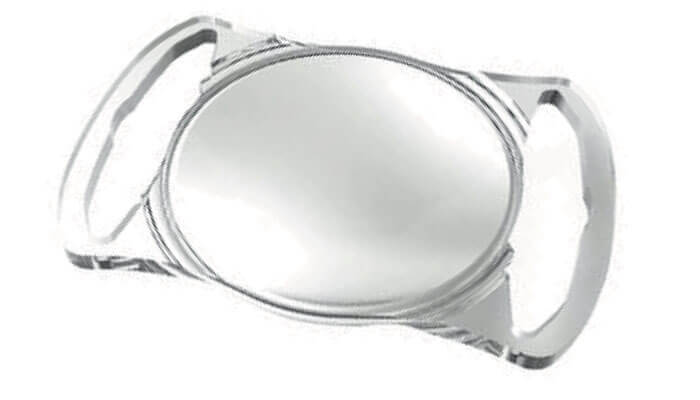
Negative dysphotopsia (a dark line at the visual periphery) and positive dysphotopsia (glare, halos and starbursts) are frustrating for patients. Several contributory factors have been identified (1, 2); among these, larger pupil size is particularly important because of associated edge effects.
As Matthias Bolz (Director, Ophthalmology Clinic, Kepler University, Austria) says, “Until recently, we could do little – large pupils always got negative dysphotopsia.” And now? “With aXA, patients don’t notice they have an IOL.” Those requiring good night vision may particularly benefit. “Dim light, when the pupil is large, is particularly associated with dysphotopsia; aXA’s large optic eliminates this issue.” Ophthalmologists also benefit, says Bolz: “Vitreo-retinal surgeons can have trouble viewing the vitreous base in the anterior part of the eye – the IOL edge interferes.”
With aXA, by contrast, the optic extends over the pupil, so the IOL edge is obscured. “The entire fundus and periphery – where pathology often occurs – are clearly visible.” And this panoramic view also facilitates retinal surgery: “Fundoscopy is easier, you see the entire retina in detail, and it’s simple to collect images with very large angles,” says Bolz. He also notes that the aXA ‘Safeloader(R)’ preloaded system is particularly helpful, as it avoids difficulties in getting the largersized lens into the cartridge. “It’s very easy – plug and play!” And the procedure? “I never have any problems,” says Bolz, adding that a bigger lens could be trickier to insert but, in practice, the aXA is so flexible that implantation is simple.
As for outcomes, Bolz describes convincing one-year rotational stability in 50 patients: “Certainly within the normal range of other lenses.” Finally, he cites two specific negative dysphotopsia cases: “I replaced their 6 mm IOLs with aXAs – they were delighted with the outcome, but also a bit angry that they didn’t get aXA IOL to begin with!”
• Monofocal, foldable, 11 mm diameter one-piece posterior chamber lens
• Fabricated from glistening-free hydrophilic, UV-blocking acrylate
• Aberration-free aspheric optic
• Posterior surface with 360-degree LEC barrier
• 10 to 30 D (0.5 D steps)
• Innovative design:
• enlarged 7 mm optic diameter – eliminates dysphotopsia
• cut-out haptic design – enhanced stability in capsular bag, more predictable refractive results, enhanced flexibility (allows insertion via 2 - 2.7 mm incision);
• Highly stable: mean absolute rotation (end of surgery to 4 months) of 1.8+/-2 degrees
• Excellent refractive outcomes (mean spherical equivalent -0.04+/-0.47D), close to target refraction (-0.02 +/- 0.15D)
• No reports of optical phenomena
• Enlarged optic improves view inside eye (3), assists retinal surgery, enables enlarged rhexis (4)

References
- I Geneva and B Henderson, Asia Pac J Ophthalmol, 6, 364 (2017). PMID: 28726357.
- A Liekfeld, “Sonderlinsen – wann und welche?”, Concept Ophthalmologie, 1, 28 (2010).
- C Skorpik et al in Freyler H, Skorpik C, Grasl M, eds, 3 Kongress der Deutschen Gesellschaft fur Introkularinsen Implantation. Vienna: Springer (1990).
- Y Takamura, et al., J Cataract Refract Surg, 40, 1850 (2014). PMID: 25201533.
